
FEBRUARY/MARCH 2006
http://www.saunalahti.fi/wtc2001/soldier5.htm
View of a Military Expert: Why the Towers of the World Trade Center collapsed
The airplanes did not a have true effect on the destruction of towers; they were needed to give an excuse for odd Orwellian wars at the same time when the USA is turned into a police nation, like the German Third Reich, to some extent. The towers took the impacts of crushing Boeing 767's. The towers were originally built to take impacts of Boeing 707's, which are approximately of the same size and was widely used in the 1970's.
Fires that kindled from the fuel in the planes were too shortlasting and weak to be able to severely damage the structure of the skyscrapers. Even in the extreme situation, the heat from a kerosene fire cannot threat the durability of a steel trunk. With the temperature of carbohydrate fires that reaches only 825 °C (approx. 1517 °F) steel weakens at 800 °C (approx. 1470 °F) and melts at 1585 °C (approx. 2890 °F). In the skyscrapers of the WTC the surroundings were not at all ideal as there were far too many steel columns and they led heat away from the burning area. WTC 1 burned for 102 minutes and WTC 2 for 56 minutes only. A fire burning much longer, from 10 to 20 hours, could slowly increase the burning temperature down to perhaps 1100 °C (approx. 2010 °F). Provided there is more substance to burn, such a fire will damage concrete and irons, but not severely heavy steel constructions.

In mid-February in Madrid, the Windsor Tower (see above)
burned for over 20 hours, which led to a fire stronger
and hotter than that in the WTC, but even the collapses
of the Windsor Tower caused by the very strong and
long-enduring fire were minimal and limited to the upper
floors. If either of the WTC tower had started to
collapse because of fires the collapse would have been
limited to only a few of the floors and then stopped.
The impossibility of a gravitational collapse is closer seen in other documents. A collapse would produce large pieces, and does not explain reports of fine dust from concrete, huge amounts of dust and pieces of steel ejected outwards.
Destruction of the towers by
explosions is clear according to the photographs and
reports of the eye witnesses. In the picture below, a
range of cutting charges have just exploded in the down
left sector and a typical white cloud is formed outwards
from the wall. Down right, explosions are seen as well.
Even a flame is seen.

In video tapes taken of the so-called
collapses of the WTC, more explosions of these cutting
charges can be seen. The explosions advance quickly, with
a gap of a couple of floors, cutting the strong steel
pillars in the outer wall. The explosions are timed so
that it appears that the tower collapses occur in the
same timing as in a gravitational collapse. The
explosions are not completely synchronized in timing,
probably a few charges are triggered by radio, and other
charges explode out of the impulses of one of these
charges (infrared, pressure wave).
More challenging problems to the demolition men, however,
were the central cores of the buildings and the 47 steel
pillars more robust than the ones on the outer rounds.
The pillars of the central cores were made of steel even
100 + 100 mm thick, thicker than the side armours of a
battle tank. Cutting those, even with explosives, is
extremely difficult. One would need to surround the whole
pillars, every single pillar on every floor intended to
get blasted, with powerful cutting charges. These charges
would have needed to be placed in such a way that the
users of the skyscrapers could not notice these
preparations.
As seen in the following pictures, the cores of the
towers were not distracted by thousands of powerful
cutting charges but by a modern thermonuclear explosive,
a small hydrogen bomb. In the picture below, a hydrogen
bomb explosion, the bomb having been placed in the cellar
and directed to the core, has reached the roof of the
tower and the upper parts of the outer walls. On its way
up the waves of fire pressure partially penetrated about
100 floors of concrete and steel. Over ten million
degrees of heat caused by a hydrogen bomb sublimised all
water within the concrete in a moment. Water exploded
extremely quickly into 24-fold volume and totally
pulverized the concrete. Even people and computers that
were in the buildings disappeared turning into heat and
light. That is why almost nothing of them was found in
the ruins.
Burning radiation is absorbed in steel so quickly that
steel heats up immediately over its melting point 1585
°C (approx. 2890 °F) and above its boiling point around
3000 C (approx. 5430 °F). In the pictures down below,
super hot groups of steel pillars and columns, torn from
wall by pressure wave, are sublimized. They immediately
turn into a vaporized form, binding heat as quickly as
possible. Bursts upwards, even visible in the picture
below, are not possible for a gravitational collapse or
for cutting charges which are used horizontally.

.........

Storax Sedan 104 Kt shallow
underground
In the upper picture the explosion is in theory 100 times
stronger than in the picture below, but in practice the
difference is only four times due to the capability of
direction of the small hydrogen bomb.
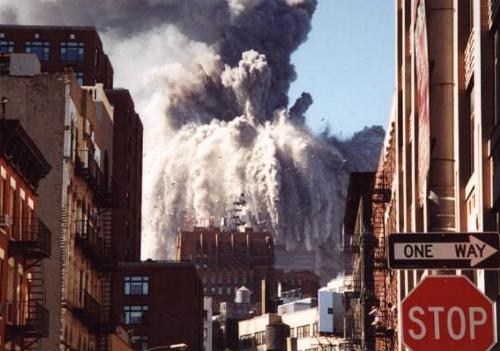
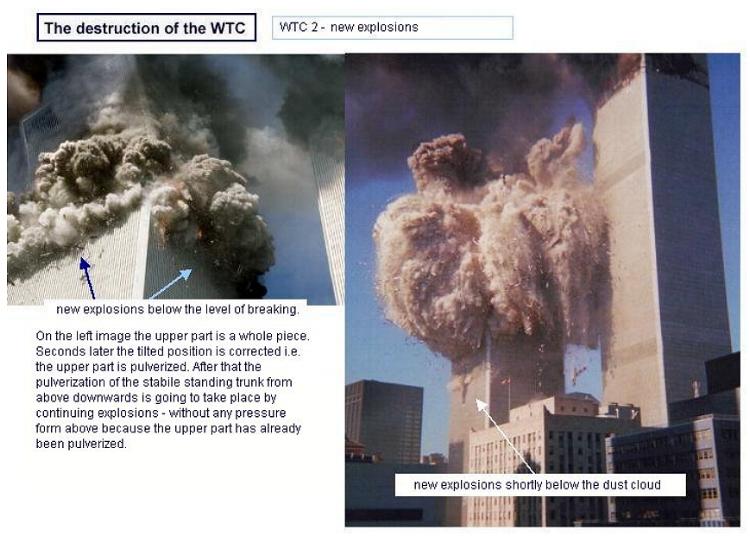
In the picture at the right, the brown shades caused by a
hydrogen bomb are seen, while the top of the tower that
is already collapsing is breaking down and the posture
straightens up as the hydrogen bomb pulverized the core
and it lost all its resistance. The piles point the
blasts of the cutting charges. (Gehue plate 12)
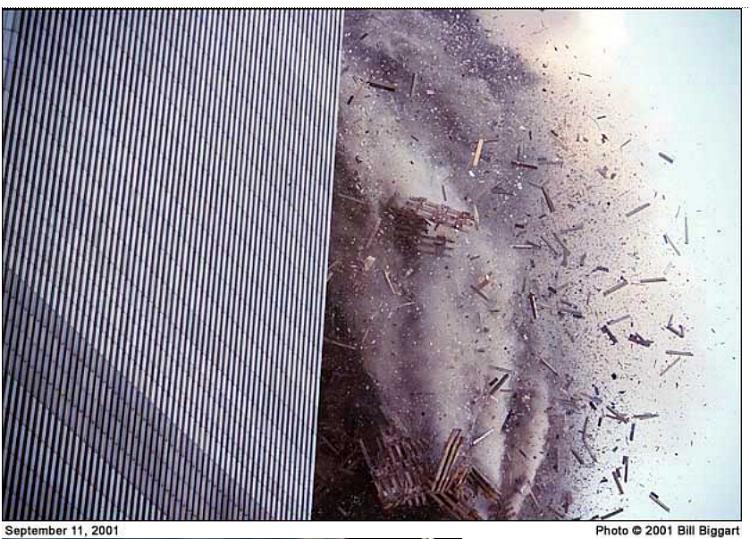
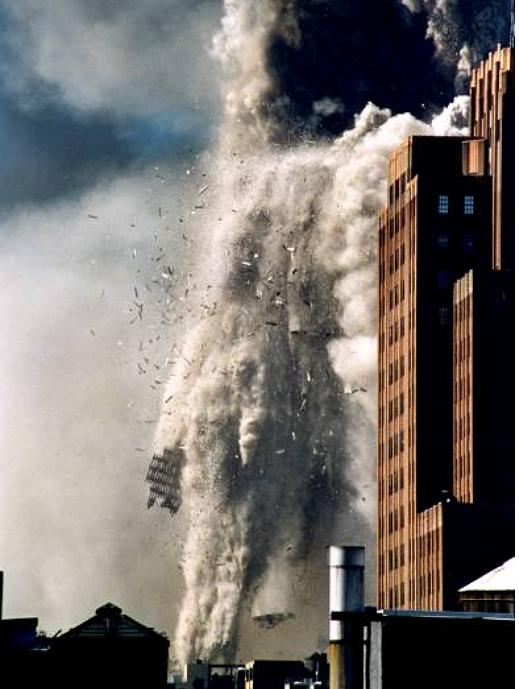
Steel pillars are turned into dust.
Extremely hot, sublimating pieces are not created with
many methods.
For comparison, pictures of subterranean nuclear
explosions where the explosion is blasting onto surface
and into the air:
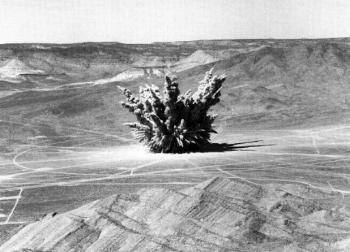
Ess1.2 Kt
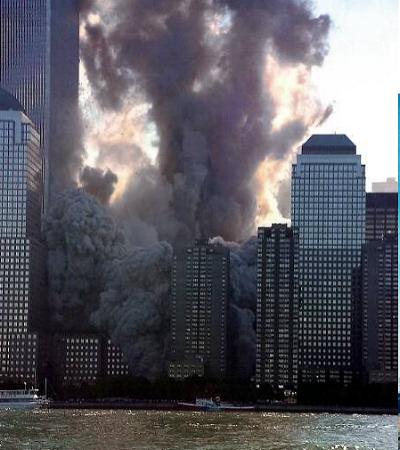
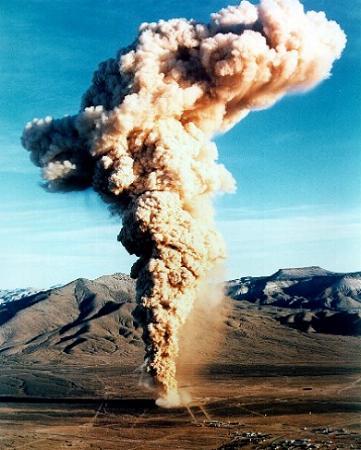
Banberry 10 Kt underground
Radioactivity in air creates shades of brown. (The
subterranean nuke in the picture on the right is 10 times
stronger than the small nuke on the left.) This is the
reason why the FBI did not search the crime scene. Ground
zeros of nuclear weapons are a health risk and belong to
the FEMA.
Writings of a Finnish Military Expert on 9/11
Written in spring 2005, a modestly language-corrected version Corrected by another person than the original author.
The photographs attached in this non-profit distribution are for securing volatile, important evidence on 9/11 for discussion and education. Author hereby grants full permission to reproduce the drawing 'The Bombs in the WTC' and his writings. You are encouraged to mail, publish and mass produce these documents or your enhanced versions of them. Due to concerns for his personal safety, the author has chosen to remain anonymous.
- The 9/11 Operation: A Summary
- The Bombs in the WTC
- The Development of Bomb Technology Related to the 9/11 Operation
- Observations Suggesting the Use of Small Hydrogen Bombs
View of a Military Expert: Why the Towers of the World Trade Center Collapsed

The Impossibility of Flying Heavy Aircraft Without Training
by Nila SagadevanNila Sagadevan is an aeronautical engineer and a qualified pilot of heavy aircraft.
There are some who maintain that the mythical 9/11 hijackers, although proven to be too incompetent to fly a little Cessna 172, had acquired the impressive skills that enabled them to fly airliners by training in flight simulators.
What follows is an attempt to bury this myth once and for all, because I’ve heard this ludicrous explanation bandied about, ad nauseam, on the Internet and the TV networks—invariably by people who know nothing substantive about flight simulators, flying, or even airplanes.
A common misconception non-pilots have about simulators is how “easy” it is to operate them. They are indeed relatively easy to operate if the objective is to make a few lazy turns and frolic about in the “open sky”. But if the intent is to execute any kind of a maneuver with even the least bit of precision, the task immediately becomes quite daunting. And if the aim is to navigate to a specific geographic location hundreds of miles away while flying at over 500 MPH, 30,000 feet above the ground the challenges become virtually impossible for an untrained pilot.And this, precisely, is what the four hijacker pilots who could not fly a Cessna around an airport are alleged to have accomplished in multi-ton, high-speed commercial jets on 9/11.
For a person not conversant with the practical complexities of pilotage, a modern flight simulator could present a terribly confusing and disorienting experience. These complex training devices are not even remotely similar to the video games one sees in amusement arcades, or even the software versions available for home computers.
In order to operate a modern flight simulator with any level of skill, one has to not only be a decent pilot to begin with, but also a skilled instrument-rated one to boot — and be thoroughly familiar with the actual aircraft type the simulator represents, since the cockpit layouts vary between aircraft.The only flight domains where an arcade/PC-type game would even begin to approach the degree of visual realism of a modern professional flight simulator would be during the take-off and landing phases. During these phases, of course, one clearly sees the bright runway lights stretched out ahead, and even peripherally sees images of buildings, etc. moving past. Take-offs—even landings, to a certain degree—are relatively “easy”, because the pilot has visual reference cues that exist “outside” the cockpit.
But once you’ve rotated, climbed out, and reached cruising altitude in a simulator (or real airplane), and find yourself en route to some distant destination (using sophisticated electronic navigation techniques), the situation changes drastically: the pilot loses virtually all external visual reference cues. S/he is left entirely at the mercy of an array of complex flight and navigation instruments to provide situational cues (altitude, heading, speed, attitude, etc.)
In the case of a Boeing 757 or 767, the pilot would be faced with an EFIS (Electronic Flight Instrumentation System) panel comprised of six large multi-mode LCDs interspersed with clusters of assorted “hard” instruments. These displays process the raw aircraft system and flight data into an integrated picture of the aircraft situation, position and progress, not only in horizontal and vertical dimensions, but also with regard to time and speed as well. When flying “blind”, I.e., with no ground reference cues, it takes a highly skilled pilot to interpret, and then apply, this data intelligently. If one cannot translate this information quickly, precisely and accurately (and it takes an instrument-rated pilot to do so), one would have ZERO SITUATIONAL AWARENESS. I.e., the pilot wouldn’t have a clue where s/he was in relation to the earth. Flight under such conditions is referred to as “IFR”, or Instrument Flight Rules.
And IFR Rule #1: Never take your eyes off your instruments, because that’s all you have!The corollary to Rule #1: If you can’t read the instruments in a quick, smooth, disciplined, scan, you’re as good as dead. Accident records from around the world are replete with reports of any number of good pilots — I.e., professional instrument-rated pilots — who ‘bought the farm’ because they screwed up while flying in IFR conditions.
Let me place this in the context of the 9/11 hijacker-pilots. These men were repeatedly deemed incompetent to solo a simple Cessna-172 — an elementary exercise that involves flying this little trainer once around the patch on a sunny day. A student’s first solo flight involves a simple circuit: take-off, followed by four gentle left turns ending with a landing back on the runway. This is as basic as flying can possibly get.Not one of the hijackers was deemed fit to perform this most elementary exercise by himself.
In fact, here’s what their flight instructors had to say about the aptitude of these budding aviators:Mohammed Atta: "His attention span was zero."
Khalid Al-Mihdhar: "We didn't kick him out, but he didn't live up to our standards."
Marwan Al-Shehhi: “He was dropped because of his limited English and incompetence at the controls.”
Salem Al-Hazmi: "We advised him to quit after two lessons.”
Hani Hanjour: "His English was horrible, and his mechanical skills were even worse. It was like he had hardly even ever driven a car. I’m still to this day amazed that he could have flown into the Pentagon. He could not fly at all.”Now let’s take a look at American Airlines Flight 77. Passenger/hijacker Hani Hanjour rises from his seat midway through the flight, viciously fights his way into the cockpit with his cohorts, overpowers Captain Charles F. Burlingame and First Officer David Charlebois, and somehow manages to toss them out of the cockpit (for starters, very difficult to achieve in a cramped environment without inadvertently impacting the yoke and thereby disengaging the autopilot). One would correctly presume that this would present considerable difficulties to a little guy with a box cutter—Burlingame was a tough, burly, ex-Vietnam F4 fighter jock who had flown over 100 combat missions. Every pilot who knows him says that rather than politely hand over the controls, Burlingame would have instantly rolled the plane on its back so that Hanjour would have broken his neck when he hit the floor. But let’s ignore this almost natural reaction expected of a fighter pilot and proceed with this charade.
Nonetheless, imagine that Hanjour overpowers the flight deck crew, removes them from the cockpit and takes his position in the captain’s seat. Although weather reports state this was not the case, let’s say Hanjour was lucky enough to experience a perfect CAVU day (Ceiling And Visibility Unlimited). If Hanjour looked straight ahead through the windshield, or off to his left at the ground, at best he would see, 35,000 feet -- 7 miles -- below him, a murky brownish-grey-green landscape, virtually devoid of surface detail, while the aircraft he was now piloting was moving along, almost imperceptibly and in eerie silence, at around 500 MPH (about 750 feet every second).
In a real-world scenario (and given the reported weather conditions that day), he would likely have seen clouds below him completely obscuring the ground he was traversing. With this kind of “situational non-awareness”, Hanjour might as well have been flying over Argentina, Russia, or Japan—he wouldn’t have had a clue as to where, precisely, he was.
After a few seconds (at 750 ft/sec), Hanjour would figure out there’s little point in looking outside—there’s nothing there to give him any real visual cues. For a man who had previously wrestled with little Cessnas, following freeways and railroad tracks (and always in the comforting presence of an instructor), this would have been a strange, eerily unsettling environment indeed.
Seeing nothing outside, Mr. Hanjour would be forced to divert his attention to his instrument panel, where he’d be faced with a bewildering array of instruments. He would then have to very quickly interpret his heading, ground track, altitude, and airspeed information on the displays before he could even figure out where in the world he was, much less where the Pentagon was located in relation to his position!After all, before he can crash into a target, he has to first find the target.
It is very difficult to explain this scenario, of an utter lack of ground reference, to non-pilots; but let it suffice to say that for these incompetent hijacker non-pilots to even consider grappling with such a daunting task would have been utterly overwhelming. They wouldn’t have known where to begin.
But, for the sake of discussion let’s stretch things beyond all plausibility and say that Hanjour—whose flight instructor claimed “couldn’t fly at all”—somehow managed to figure out their exact position on the American landscape in relation to their intended target as they traversed the earth at a speed five times faster than they had ever flown by themselves before.Once he had determined exactly where he was, he would need to figure out where the Pentagon was located in relation to his rapidly-changing position. He would then need to plot a course to his target (one he cannot see with his eyes—remember, our ace is flying solely on instruments).
In order to perform this bit of electronic navigation, he would have to be very familiar with IFR procedures. None of these chaps even knew what a navigational chart looked like, much less how to how to plug information into flight management computers (FMC) and engage LNAV (lateral navigation automated mode). If one is to believe the official story, all of this was supposedly accomplished by raw student pilots while flying blind at 500 MPH over unfamiliar (and practically invisible) terrain, using complex methodologies and employing sophisticated instruments.
To get around this little problem, the official storyline suggests these men manually flew their aircraft to their respective targets (NB: This still wouldn’t relieve them of the burden of navigation). But let’s assume Hanjour disengaged the autopilot and auto-throttle and hand-flew the aircraft to its intended—and invisible—target on instruments alone until such time as he could get a visual fix. This would have necessitated him to fly back across West Virginia and Virginia to Washington DC. (This portion of Flight 77’s flight path cannot be corroborated by any radar evidence that exists, because the aircraft is said to have suddenly disappeared from radar screens over Ohio, but let’s not mull over that little point.)
According to FAA radar controllers, “Flight 77” then suddenly pops up over Washington DC and executes an incredibly precise diving turn at a rate of 360 degrees/minute while descending at 3,500 ft/min, at the end of which “Hanjour” allegedly levels out at ground level. Oh, I almost forgot: He also had the presence of mind to turn off the transponder in the middle of this incredibly difficult maneuver (one of his instructors later commented the hapless fellow couldn’t have spelt the word if his life depended on it).The maneuver was in fact so precisely executed that the air traffic controllers at Dulles refused to believe the blip on their screen was a commercial airliner. Danielle O’Brian, one of the air traffic controllers at Dulles who reported seeing the aircraft at 9:25 said, “The speed, the maneuverability, the way that he turned, we all thought in the radar room, all of us experienced air traffic controllers, that that was a military plane.”
And then, all of a sudden we have magic. Voila! Hanjour finds the Pentagon sitting squarely in his sights right before him.
But even that wasn’t good enough for this fanatic Muslim kamikaze pilot. You see, he found that his “missile” was heading towards one of the most densely populated wings of the Pentagon—and one occupied by top military brass, including the Secretary of Defense, Rumsfeld. Presumably in order to save these men’s lives, he then executes a sweeping 270-degree turn and approaches the building from the opposite direction and aligns himself with the only wing of the Pentagon that was virtually uninhabited due to extensive renovations that were underway (there were some 120 civilians construction workers in that wing who were killed; their work included blast-proofing the outside wall of that wing).I shan’t get into the aerodynamic impossibility of flying a large commercial jetliner 20 feet above the ground at over 400 MPH. A discussion on ground effect energy, tip vortex compression, downwash sheet reaction, wake turbulence, and jetblast effects are beyond the scope of this article (the 100,000-lb jetblast alone would have blown whole semi-trucks off the roads.)
Let it suffice to say that it is physically impossible to fly a 200,000-lb airliner 20 feet above the ground at 400 MPH.
The author, a pilot and aeronautical engineer, challenges any pilot in the world to do so in any large high-speed aircraft that has a relatively low wing-loading (such as a commercial jet). I.e., to fly the craft at 400 MPH, 20 feet above ground in a flat trajectory over a distance of one mile.
Why the stipulation of 20 feet and a mile? There were several street light poles located up to a mile away from the Pentagon that were snapped-off by the incoming aircraft; this suggests a low, flat trajectory during the final pre-impact approach phase. Further, it is known that the craft impacted the Pentagon’s ground floor. For purposes of reference: If a 757 were placed on the ground on its engine nacelles (I.e., gear retracted as in flight profile), its nose would be almost 20 above the ground! Ergo, for the aircraft to impact the ground floor of the Pentagon, Hanjour would have needed to have flown in with the engines buried 10-feet deep in the Pentagon lawn. Some pilot.
At any rate, why is such ultra-low-level flight aerodynamically impossible? Because the reactive force of the hugely powerful downwash sheet, coupled with the compressibility effects of the tip vortices, simply will not allow the aircraft to get any lower to the ground than approximately one half the distance of its wingspan—until speed is drastically reduced, which, of course, is what happens during normal landings.
In other words, if this were a Boeing 757 as reported, the plane could not have been flown below about 60 feet above ground at 400 MPH. (Such a maneuver is entirely within the performance envelope of aircraft with high wing-loadings, such as ground-attack fighters, the B1-B bomber, and Cruise missiles—and the Global Hawk.)
The very same navigational challenges mentioned above would have faced the pilots who flew the two 767s into the Twin Towers, in that they, too, would have had to have first found their targets. Again, these chaps, too, miraculously found themselves spot on course. And again, their “final approach” maneuvers at over 500 MPH are simply far too incredible to have been executed by pilots who could not solo basic training aircraft.
Conclusion
The writers of the official storyline expect us to believe, that once the flight deck crews had been overpowered, and the hijackers “took control” of the various aircraft, their intended targets suddenly popped up in their windshields as they would have in some arcade game, and all that these fellows would have had to do was simply aim their airplanes at the buildings and fly into them. Most people who have been exposed only to the official storyline have never been on the flight deck of an airliner at altitude and looked at the outside world; if they had, they’d realize the absurdity of this kind of reasoning.
In reality, a clueless non-pilot would encounter almost insurmountable difficulties in attempting to navigate and fly a 200,000-lb airliner into a building located on the ground, 7 miles below and hundreds of miles away and out of sight, and in an unknown direction, while flying at over 500 MPH — and all this under extremely stressful circumstances.